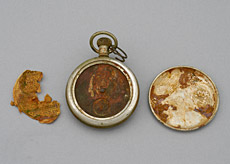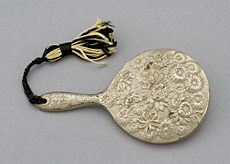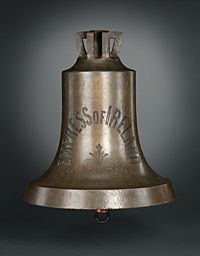Treasures from the Empress of Ireland
May 1, 2013Its sinking on May 29, 1914 on the St. Lawrence River near Rimouski, Quebec, was the worst-ever Canadian maritime disaster, with 1,012 lives lost, comparable to the sinking of the RMS Titanic in 1912. Yet few Canadians have ever heard of the RMSEmpress of Ireland, an ocean liner used primarily to transport European immigrants up the St. Lawrence toward the promised land of the Canadian West.

Pocket watch recovered from the wreck of the Empress of Ireland
IMG2012-0373-0121-Dm © Canadian Museum of Civilization

Hand mirror recovered from the wreck of the Empress of Ireland
IMG2012-0373-0123-Dm © Canadian Museum of Civilization
Struck at night in dense fog by the Storstad a Norwegian coal-carrier, the Empresssank within 15 minutes. Opening in May 2014, to commemorate the 100th anniversary of this tragedy, an exhibition at the Canadian Museum of Civilization will vividly evoke the drama and terror of that night in 1914. The exhibition will feature dozens of artifacts salvaged from the ship’s wreck, and now part of the Museum’s collection. Over the coming year, these and other related artifacts will be examined, restored and made ready for exhibition by the Museum’s team of conservators.
Art Meets Science

Fog bell from the Empress of Ireland
Photo Frank Wimart, IMG2012-0281-0002-Dm
© Canadian Museum of Civilization
The Empress of Ireland collection, recently acquired through the donor-supported National Collection Fund, includes navigational instruments, personal items such as jewelry and a silver pocket watch, as well as china, silverware and the pièce de résistance, the ship’s 200-kilogram fog bell. Museum curator Dr. John Willis calls the collection “the single most important 20th century acquisition that we’ve made to date.”
“We’re at the beginning of the process of registering and photographing the artifacts and assessing them for conservation treatment and storage needs,” explains conservator Amanda Gould. She describes a conservator’s work space as “a melding of an artist’s studio and a science lab. We use organic solvents and various kinds of chemicals so we need protective equipment, but we also need a craftsperson’s tools to work with the artifacts. Each is different, so you have to have empathy for the materials and its maker’s intent. That’s what guides you.”
The Exhibition
The Empress of Ireland collection was acquired from a private collector who, also collected hundreds of documents associated with the Empress, its passengers or the ship’s owner, the Canadian Pacific Steamship Company. For Amanda Gould, some of the most moving pieces in the collection relate to Florence Barbour, an eight-year-old passenger who lost her mother and sister (her father had died earlier in a mining accident) in the wreck. “We have her hand-written memoir and absolutely beautiful studio portraits of Florence and her family.” Florence was saved by another passenger, her uncle Robert W. Crellin.
As well as telling the stories of the crew and the individual passengers, the exhibition will offer a window into early 20th century Canadian immigration. The RMS Empress of Ireland and her sister ship the RMS Empress of Britain transported hundreds of thousands of European immigrants from Liverpool, England to Canada. According to some estimates, as many as one million present-day Canadians may have ancestors who came to this country on one of the ships.
The sinking of the Empress was front-page news around the world but within a few months, with the start of the First World War, it faded quickly from the national memory.
To learn how donating to the National Collection Fund helps protect Canada’s heritage, please call the Development Department at 1-800-256-6031 or historymuseum.ca/support and warmuseum.ca/support.